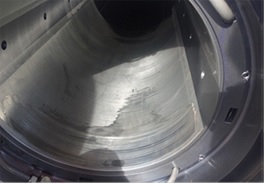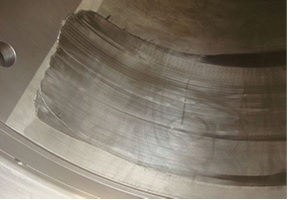DNV GL has observed an increasing trend in reported incidents involving aft propeller shaft bearing damages. Most of the damages reportedly have developed within a short period of time, typically a few minutes to an hour, under the respective operating conditions.
This technical news reflects what is suspected to be one of the contributory factors to some of these types of damages, namely operation involving incomplete propeller immersion. It is recommended that operators undertake suitable precautions and respective mitigating measures in this regard.
Typical damages observed and their consequences

Figure 2: Typical damages observed in this regard involve wiping of white-metal based bearing material in the aft part of the bearing, indicating a complete or partial loss of the hydrodynamic oil film under the reported operating conditions.
Physical contact of the shaft with the bearing material is reflected by an elevated bearing temperature and, in most cases, at an exponential rate of rise.
In an isolated case involving extended operation beyond the alarm point (normally 65°C), bearing damage was even observed with a slower rate of temperature rise.
The reported damages resulted in expensive and time-consuming repairs. Bearing failure may lead to the risk of total loss or diminishment of main propulsion function capacity and, in some cases, may be detrimental to the propeller shaft in the event of steel-to-steel contact.
In the event of long-term operation with incomplete propeller immersion which does not result in an immediate failure, the risk of fatigue-related bearing failures arising out of excessive cyclic loading and associated shear forces on the bearing will co-exist.


